Function integration and space utilization strategy of container house in community center
Table of Contents
Function Integration in Container House Design for Community Centers
Container houses have gained popularity in recent years due to their versatility, affordability, and sustainability. These structures, made from repurposed shipping containers, have been used for various purposes, including residential homes, offices, and even community centers. In this article, we will explore the function integration and space utilization strategy of container houses in community centers.
One of the key advantages of using container houses in community centers is their ability to integrate multiple functions within a compact space. By carefully designing the layout and interior of the containers, architects and designers can create a space that serves a variety of purposes, such as meeting rooms, classrooms, offices, and recreational areas. This function integration allows community centers to maximize their use of space and provide a wide range of services to the community.
In addition to function integration, space utilization is another important aspect of container house design for community centers. Containers are inherently modular and can be easily stacked or arranged in different configurations to create unique and efficient spaces. By utilizing the vertical space as well as the horizontal space, designers can maximize the use of limited land area and create a dynamic and visually interesting environment for community members.

Furthermore, container houses can be easily customized to meet the specific needs of a community center. Whether it’s adding windows for natural light, insulation for temperature control, or partitions for privacy, containers can be modified to create a comfortable and functional space for various activities. This flexibility in design allows community centers to adapt to changing needs and accommodate different types of events and programs.
Another benefit of using container houses in community centers is their sustainability. By repurposing shipping containers, which would otherwise end up in landfills, community centers can reduce their environmental impact and promote a more sustainable way of building. Additionally, containers are durable and long-lasting, requiring minimal maintenance and upkeep over time.
When designing a container house for a community center, it is important to consider the needs and preferences of the community members. By involving stakeholders in the design process, architects and designers can create a space that reflects the values and culture of the community. This participatory approach not only ensures that the space meets the needs of its users but also fosters a sense of ownership and pride among community members.
In conclusion, function integration and space utilization are key considerations in the design of container houses for community centers. By carefully planning the layout, maximizing the use of space, and customizing the design to meet the needs of the community, architects and designers can create a versatile, sustainable, and engaging space for community members to gather, learn, and connect. Container houses offer a unique opportunity to rethink traditional building methods and create innovative and inclusive spaces that benefit both the environment and the community.
Maximizing Space Utilization Strategies for Container Houses in Community Centers
Container houses have gained popularity in recent years due to their affordability, sustainability, and versatility. These structures, made from repurposed shipping containers, offer a unique solution for housing needs in various settings, including community centers. When it comes to maximizing space utilization in community centers, integrating container houses can be a strategic and efficient solution.
One of the key benefits of using container houses in community centers is their modular nature, which allows for easy integration into existing spaces. By strategically placing container houses within the center, unused or underutilized areas can be transformed into functional living spaces. This not only maximizes the use of available space but also provides an opportunity to create additional housing units for community members in need.
In addition to their modular design, container houses offer flexibility in terms of layout and configuration. With proper planning and design, these structures can be customized to meet the specific needs of the community center. For example, container houses can be used to create temporary housing for individuals experiencing homelessness, or to provide affordable housing options for low-income families. By carefully considering the layout and design of container houses, community centers can effectively address housing challenges within their communities.
Furthermore, container houses can be integrated with existing infrastructure within the community center to enhance functionality and efficiency. For example, container houses can be connected to utilities such as water, electricity, and sewage systems to ensure that residents have access to essential services. By integrating container houses with existing infrastructure, community centers can provide a comfortable and sustainable living environment for residents.
Another important consideration when integrating container houses into community centers is the overall aesthetic and design of the space. While container houses offer a unique and modern look, it is important to ensure that they blend seamlessly with the existing architecture and design of the center. By incorporating elements such as landscaping, outdoor seating areas, and communal spaces, container houses can enhance the overall aesthetic appeal of the community center while maximizing space utilization.
In conclusion, the integration of container houses in community centers offers a practical and efficient solution for maximizing space utilization. By leveraging the modular design, flexibility, and sustainability of container houses, community centers can create additional housing units, address housing challenges, and enhance the overall functionality of the space. With careful planning, design, and integration with existing infrastructure, container houses can play a key role in creating a vibrant and inclusive community center that meets the needs of residents. By embracing innovative solutions such as container houses, community centers can continue to evolve and adapt to the changing needs of their communities.







